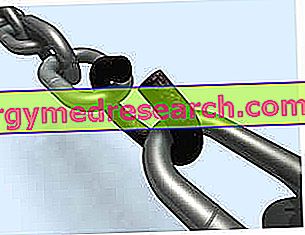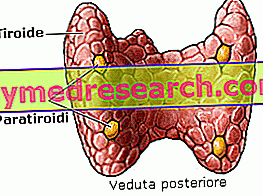Edited by Samuele Tedeschi
The problems related to the analysis and treatment of back pain in general and low back pain in particular, are of extreme interest for the personal trainer and the physiotherapist, as the modern lifestyle leads to a sort of postural imbalances that go to create in customers, painful problems related to posture.

Lumbago refers to the painful situation that affects an area bounded at the top by the horizontal that passes through D12, and at the bottom by the fold of the buttocks; we talk about lumbosciatalgia if the pain also affects the lower limb.
By dorsalgia we mean the painful framework that affects the entire area of the dorsal vertebrae, hence from D12 to D1. The pain is felt by turning or flexing the thoracic tract, in the most serious cases we are witnessing the blockage of the back, but this is caused by a set of causes, it is therefore rare that it originates from a single structure. This confirms the fact that the individual must be analyzed in a global manner, because the problems of the human body cannot be categorized by sectors with watertight compartments, as unfortunately official medicine is doing.
By contrast, cervicalgia refers to the problems related to the cervical tract of the spine. Which can be simple limitations of movement of rotation and inclination, or painful pictures derived from hernias or cervical arthrosis.
Given the high percentage of subjects affected by back pain, the social costs that the problem determines are enormous.
The studies published in the literature are numerous and investigate the problem in all its facets: from the occupational, sports, surgical, rehabilitative, etc. When we talk about back pain, we must take into account numerous aspects, both anatomical and functional, and subjective, so much so that it is very difficult to codify the problem in a few diagnostic categories.
If the etiopathogenesis of the problem is very wide, there are also numerous methods of intervention, which may include pharmacological treatment, the manual approach, the use of electromedical devices, the use of exercises for toning weak muscles, work in the water.
The choice of treatment responds to many variables, which may be related to the type of pathology, the type of equipment available, the state of inflammation of the affected tract, etc.
Before proceeding to analyze the various types of treatment that I personally prefer to solve the problems of back pain, I would like to remember how the human body works, because it is itself that conditions the method used to solve painful problems and it is to it that the operator's job must adapt. The human body is an articulated structure adaptable, passively, actively and autonomously under various conditions. The mechanical structure is formed by rigid elements (bones), elastic-dynamic sealing (ligaments and bands), and dynamic (muscles); all correlated to form a complex biodynamic system.
The structures of the human body obey the laws of physics, such as those of static and dynamic equilibrium, levers and fluids. Since the body structure is adaptable, we will have control systems that guarantee that this adaptability does not exceed certain limits, beyond which it is no longer possible to compensate. The main control systems are: the ophthalmic system, the vestibular system, the proprioceptive system and the exteroceptive one. Within these systems we find the motor engram, the kinetic chains, the attitudes, the positions and the psycho-physical experience of each individual.
Kinetic chains are the muscular systems through which our posture is articulated and modified. Physics states that a kinetic chain is a system composed of rigid segments, joined by mobile joints defined as joints. Our body is composed of many kinetic chains, the segments are represented by the bones while the joints represent the joints. Muscles are the "engine" of the kinetic chain. This engineering type definition, however, is not completely applicable to the physiology of human movement because the muscular apparatus cannot be compared to a rigid mechanical system, but is to be considered as flexible and plastic.
The main kinetic chains to be considered for the treatment of back pain are: the posterior kinetic chain, the diaphragmatic kinetic chain, the transverse kinetic chains.
The diaphragm has a key role in back pain, it is an uneven and asymmetrical muscle that separates the chest from the abdomen.

When an inspiration is triggered, the diaphragm contracts and its dome lowers until it finds the resistance of the viscera and tendon of the diaphragm. This triggers a depression inside the chest box and then the entry of air into it. Conversely, when the diaphragm relaxes and rises upwards, the expiratory mechanism is triggered.
The retraction of this muscle, which can be triggered for reasons of stress, psycho-physical trauma, asthma, etc. forces the diaphragm to an expiration always braked and to an act of forced and prolonged inspiration.
The retraction of this muscle can trigger many diseases. Once contracted, in fact, the muscle exerts a coercing force between origin and insertion causing a compression of the lumbar vertebrae that can lead to lumbago, discopathies and disc protusions. It can also be the precursor of stomach problems such as hiatal hernia, where the stomach escapes upward to escape the depression inflicted by the diaphragm, giving rise to a stomach lapse. Finally, the close contact between the psoas and the diaphragm can lead to a contractile process of the same psoas that is a hyperlordant of the spine.
We must not forget, however, that by not using the diaphragm properly, a hyper-utilization of the accessory musculature is triggered at rest, consisting of: sternocleidomastoid, small pectoralis, subclavianus, trapezius, scapula elevator, large dentate, great dorsal and erector trunk. These hyperactivated muscles will in turn undergo retraction, therefore decompensation, causing possible neck pains, problems with the rotator cuff, limitation of movements, etc.
Psyche and posture are therefore connected ; the thread that unites these two elements is often the diaphragm, but this is a complex topic, sometimes chaotic of posture, both under the diagnostic aspect (often we tend to forget or not to mention the events that caused stress or trauma to our organism, so it is unlikely that during anamnesis these events will spring out) that under the re-educational-therapeutic aspect. It is also true that the subject is so important and integrated into the system that it cannot be ignored and in some cases it is difficult, not to say impossible, to identify how much the postural action conditions a psychological component and vice versa.
To conclude we analyze the strategy to be used when we are dealing with a patient-client who complains of spinal pain. First and foremost it is absolutely not to underestimate a sporadic pain in the back, as it informs us that we have an alarm bell in place. We are probably in front of a postural alteration which, continuing in its course, could determine disc protusions, arthrosis, functional limitations, tears, contractures, etc.
The anamnesis will be carried out carefully to understand the daily habits, to learn the experience of the client in question and the events that led to the emergence of algia. It is also important to know how the time of delivery came about, whether it was breast-fed or if it used a bottle etc. In short, nothing must be omitted.
Observe the patient- client is a must, slightly broken teeth, asymmetrical dental arches, tight jaw, obvious dental fillings and with harmful amalgam, glasses not perfectly symmetrical, head tilted or rotated abnormally or asymmetrically, shoulders to different heights or intramural, asymmetrical size triangles, how to breathe, how to position yourself on the chair and how to distribute loads, valgus or varus of the knees, abnormal shoe wear, etc.
After the medical history it will be necessary to go to perform a postural analysis with adequate tests. For the sake of completeness, even if briefly, I present a series of tests to be performed on the subject : an earlier bending test with an assessment of the symmetry of the pelvis, one can help with a mason's bubble to have a better overview; head rotation test; head inclination test; lateral tilt test of the trunk; palpation of the mandibular and hyoid muscles; palpation of dorsal and trapezius muscles, to appreciate the presence or absence of contractures or asymmetries; evaluation of sacroiliac and piriformis; evaluation of elasticity of the ischio-crural muscles, of the femoral, ileo-psoas and femoral rotators; adductor evaluation; evaluation of the length of the lower limbs; Romberg test; Fukuda test; De Cyon test; nystagmus research; Cover test; ATM exam; examination on the stabilometric platform.
The postural re-education protocol will be performed taking into account these assessments, the training of proprioception should not be forgotten as it plays a fundamental role in the positioning of one's body and body segments in space. Postural re-education should begin with a general rebalancing, thus lengthening the muscles and then toning it in a balanced and proportionate manner. Of course, there are several schools of thought regarding how to act in stretching muscles, I personally believe that a decompensated global stretching is the right way to act. It is not correct to follow the fashions when the well-being and health of the person is at stake, it is necessary to use methods supported by scientific studies that prove their effective effectiveness.
After a session of global decompensated stretching it is more than appropriate to perform a massage session that further relaxes the patient and in cases where there is an important inflammation one can apply kinesiological taping which will perform a decontracting, draining action and proprioceptive on the musculature.



